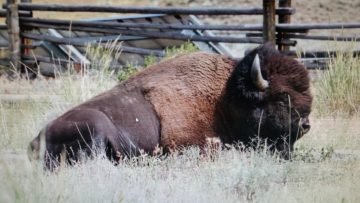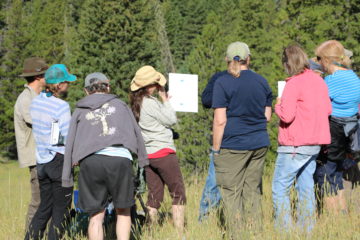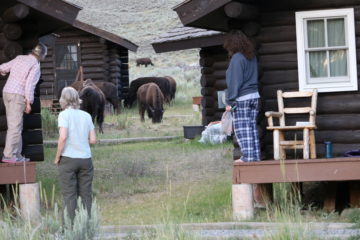By JAN LARSON McLAUGHLIN
BG Independent News
When Harold Brown retired after 42 years in the news business, he went about as far off the grid as he could go – sharing his summer camp where the buffalo roam, where a mountain blocks out cell service, and where the closest grocery store is about 50 miles away.
“I am living the dream,” Brown said.
Brown, of Bowling Green, has spent the last two summers working with the field seminars in Yellowstone National Park. He decided to take on the job after spending five or six vacations learning from the park seminars himself.
“It’s as close as anywhere in the lower 48 to the way it was when the Europeans got here,” Brown said of Yellowstone.
While nothing is pristine anymore, Yellowstone is about as close as it gets, he said.
“You’re just in a totally different place,” he said. “It’s just a really good place to spend time.”

A bison sits on the ground at Lamar Buffalo Ranch.
The park is spread across 3,500 square miles, primarily in Wyoming, but also Montana and Idaho. The views are spectacular – even for someone who is a regular visitor and now a seasonal employee. And the acreage is constantly changing, Brown said, with new geysers popping up, hot springs, an active volcano and thousands of small earthquakes a year.
“The place is alive. It’s changing all the time,” through the acts of Mother Nature.
The night skies are particularly striking, Brown said. “It’s unbelievable. I’ve never seen the Milky Way like I’ve seen it there.”
The park, which was originally dedicated in 1872 when Ulysses S. Grant was president, is also seeing some strain from so many visitors. For the second summer in a row, Yellowstone National Park exceeded 4 million visitors, with as many as 30,000 a day. The park infrastructure, with older narrow roadways, was built to handle a maximum of 2 million people a year.
“We are loving our parks to death,” Brown said.
The field seminars give people a chance to spend a few days studying 54 topics like nature photography, animal migration, wildflowers, fly fishing, Native American plant uses, birds of prey, hiking, bears, wolves and buffalo.
With help from the National Park Service, much of the wildlife has made a comeback in Yellowstone. More than a century ago, the bison population had dropped to about two dozen. Now it stands around 5,500, Brown said.
The park has strong populations of elk, grizzly and black bears, badger, otter and golden eagles. Wolves have also been reintroduced into the park.

A field seminar for artists
Keeping the wildlife at healthy numbers is a delicate balancing act, he said.
Brown and all the other field seminar workers are trained for what to do if a bear attacks, and they don’t leave camp without bear spray on their belts.
The bison often block the roadways in the park, and feel no need to budge for motorists. “They’ve become a bit of a problem. You don’t tell a bison where to go,” he said of the 2,000-pound animals. “It could take a half hour for a ranger to show up” and move them off the roads.
There are no fences at the park borders, so the bison often stray into neighboring land – such as Gardiner, Montana, where the bison have found some green pastures. “They often have to clean up after the bison on the football field,” Brown said.

Field seminar participants watch bison graze among the cabins at Lamar Buffalo Ranch.
The camp where Brown and field seminar participants stay is called Lamar Buffalo Ranch – and as the name implies, the buffalo make themselves at home there.
“When they show up, we stay in the cabin,” he said. And nighttime trips from the bunkhouse to the bathroom always require a flashlight. “Anytime you go outside, you look.”
The field seminar workers and participants stay at the camp, which is 10 miles from the nearest power source. The camp is powered by a propane generator and some solar panels. The small staff drives a 14-passenger van for the seminar participants, cleans the cabins, washhouse, the bunkhouse and kitchen. The groups share some meals, with grocery trips every 10 days or so since the closest store is nearly a 100-mile round-trip in Gardiner, Montana.
The cell service is nearly non-existent, Brown said.
“Usually we have to drive four miles to get from behind a mountain” to be able to use cell phones, he said. “If you want to be away from things, this is the place. We’re considered off the grid.”
“It’s just a great place to immerse yourself,” he said.
On this 100th anniversary of the National Parks Service, Brown does have some concerns about the future of the parks. Several western states want the federal government to turn over the federal lands to the states, and possibly to allow for their sale.
“It’s going to be an issue, especially with the election,” he said.
Brown isn’t sure if he will be returning to the ranch next summer or move on to a new adventure. But if he heads back to Yellowstone, he expects the park to still thrill him with its ever-changing nature. “Who knows what it will be the next time I get there.”

